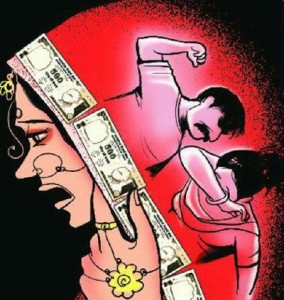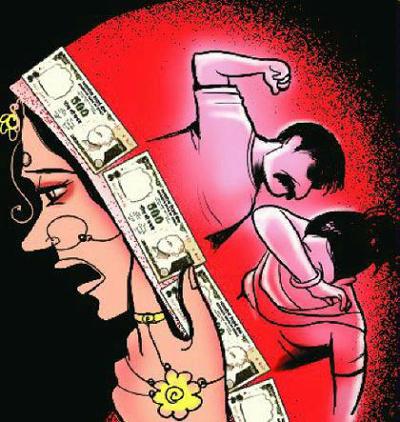In this blog post, Abhiraj Thakur, a Student at NALSAR University of Law, Hyderabad, explores the problems with the current law of dowry death and cruelty in India. Along with highlighting various suggestions of reforms to the current law, the writer suggests a possible reform.
Purpose of the Reform Suggestion
The proposals under this law reform suggestion are aimed to curb the menace of dowry and dowry deaths and precisely address the consequent legal technicalities that may arise. The question of amendment of Section 304-B of the Indian Penal Code, 1860 to have more precise and stringent punishments according to facts of the case would be examined through this proposal. The distinction between the different possible causes of dowry death needs to be sought, for which punishment would need to be awarded accordingly, as opposed to one punishment for any offence falling under that section. It will also take into consideration making offences under Section 498A of the Indian Penal Code compoundable, due to the present situation of frequent occurrences of misuse of this Section. Factors are to be evaluated in every individual case, without blind assumptions, but with certain methods of drawing probable conclusions. It should work efficiently and adequately but at the same time should not be counter-productive.
Why there is a need for Amendment?
The issues that stand today with these laws are owed to the lack of clarity and lack of distinction and classification within the laws concerning interrelated areas of Dowry, Cruelty and Dowry Death.
This ambiguity, though it may have had its advantages at one point in time in bringing the victims to justice, is in recent years causing many counter-productive results. On the other hand, in some cases, the facts may not meet certain conditions and may not fall into pigeon-holes of known offences. Peculiarities of the case may cause it to avoid falling under a certain offence, and proper procedure may not be taken as a result. Cruelty, as dealt with in Section 498-A of IPC, may be present in numerous forms, but may not be recognised in peculiar cases if the facts do not satisfy the required legal ingredients. Proof required for certain offences causes a burden on the victim, and lack of evidence should not be the reason for denial of justice.
Measures ought to be taken to ensure that in cases of dowry death, there are different possibilities as to how the death of the wife could have occurred, and whether it would necessarily be classified as ‘dowry death.’ Section 304-B of IPC should be amended to include and specify the distinction between ‘murder’ and ‘suicide’ that cause the death in the case of dowry death. It is a vital fact that should significantly affect the case and the suitable punishment given. Because it is currently treated as ‘murder’, one would have to ponder if the same degree of punishment is applicable in all the cases. Since it is considered as murder, the death sentence, if awarded, would be acceptable legally though the dictum of ‘rarest of rare case,’ may have to be adhered to.
Dowry Death
Punishment for Dowry Death is explicitly specified in the Indian Penal Code. It is stated in Section 304-B of Indian Penal Code, of which sub-section (2) specifies the punishment for Dowry Death as ‘imprisonment for a term which shall not be less than seven years but which may extend to imprisonment for life.’
 In recent times, the issue of allowing a death sentence for the act of Dowry Death has been a contentious one. In the 202nd Law Commission Report, it has been concluded and expressed that though there is a scope for providing death sentence for the offence of dowry death under Section 304-B, there is no substantive reason to do so. They concluded that because there is no warrant, it would not be amended.[1]
In recent times, the issue of allowing a death sentence for the act of Dowry Death has been a contentious one. In the 202nd Law Commission Report, it has been concluded and expressed that though there is a scope for providing death sentence for the offence of dowry death under Section 304-B, there is no substantive reason to do so. They concluded that because there is no warrant, it would not be amended.[1]
However, the commission did find that there was a need for a classification and distinction to be made regarding dowry death and murder, which are frequently confused for one another. This would greatly affect the case and proceedings, creating a significantly different outcome. With the view in mind that dowry death is to be taken seriously, and justice is to be duly served, it has been treated as a criminal offence with a general definition and punishment.
Sub-section (1) defines dowry death as: ‘Where the death of a woman is caused by any burns or bodily injury or occurs otherwise than under normal circumstances within seven years of her marriage and it is shown that soon before her death she was subjected to cruelty or harassment by her husband or any relative of her husband for, or in connection with, any demand for dowry, such death shall be called “dowry death”, and such husband or relative shall be deemed to have caused her death…’[2]
Created with a good intention, this law is not necessarily incompetent, but rather vague, with limitations. It requires amendment in the area of defining and specifying the nature of the offence so that the definition is widened and allows more acts to be charged as offences. If an offence dowry death is just classified under a single category, it may exclude certain cases that may otherwise be considered dowry death. This creates another problem, where an offence may be considered dowry death although it is in fact not. This grey area should be eradicated, and a clear distinction should be made between dowry death and other offences.
In the 202nd Law Commission Report after examination had suggested through a valedictory remark:
Reiterating the rider voiced in the case of K. Prema S.Rao Vs Yadla Srinivasa Rao by the Supreme Court, “the Legislature has by amending the Penal Code and Evidence Act made Penal Law more strident for dealing with punishing offences against married women. Such strident laws would have a deterrent effect on the offenders only if they are so stridently implemented by the law courts to achieve the legislative intention” [3]
It was expressed that the system would need to be sensitive and responsive to the needs of the situation arising from the incidents of dowry death. ‘Dowry deaths are manifestation of socio-economic maladies prevailing in the society.’ It is necessary that this is addressed at different levels, instead of legal redressal level alone, to curb the menace of dowry deaths.
Cruelty in Marriage
Cruelty is enumerated under Section 498-A in the Indian Penal Code.[4]
As mentioned in the 243rd Law Commission Report, the criticism of over-implication observed by the Courts is justified by the statistical data of the cases under Section 498-A. This misuse of the Section 498-A is evident from the high number of cases pending in various courts across the country. Based on data provided by High Courts during 2011, 3.4 lakh cases under Section 498-A of the IPC were pending trial in various courts by the end of 2010. There have been as many as 9.38 lakh accused implicated in these cases.
There has been an evident unnecessary accusation of more than one person within cases.[5] This may be due to the fact that the definition allows for wide interpretation and can be seen as an easy opportunity. A burden of requirement of proof needs to be imposed on the party that allows for only certain cases to be accepted. Since the number of cases being accepted into courts is the reason for ineffectiveness, it may be suggested to permit allowance for bailable, cognizable cases that are compoundable with permission of courts. There should also be punishment for parties in case of proven misuse of this section.
In the 237th Law Commission Report, proposed to add sub-section (2A) to Section 320 CrPC. The proposed provision will ensure that the offer to compound the offence is voluntary and free from pressures and the wife has not been subjected to ill-treatment after the offer of compounding. Incidentally, it underscores the need for the Court playing an active role while dealing with the application for compounding the offence under Section 498-A.[6]
Intersection of Cruelty and Dowry Death
It was held by the Honorable Apex Court in Shanti Vs State of Haryana, that Section 304B and 498A are not mutually exclusive. Two distinct offences are observed and dealt with. A person that is charged and acquitted under Section 304B can be convicted under Section 498A without a charge being framed if such a case is made. However, from the perspective of practice and procedure and to avoid technical shortcomings, it is sensible in such cases to frame charges under both the Sections. If the case is established against the accused he can be convicted under both the Sections but no separate sentence need be awarded under Section 498A in view of a substantive sentence being awarded for a major offence under Section 304B.[7] [8]
In Panakanti Sampath Rao Vs State of A.P: Accused was charged with the commission of offences under Sections 498A, 302 and 304B of the IPC and Sections 3 and 4 of the Dowry Prohibition Act. He was acquitted of the offence of murder under Section 302 but was convicted on the other counts. Life imprisonment was awarded under Section 304B other than the punishment awarded under other charges. On appeal, the High Court found the accused guilty of the offence under Section 302 of the IPC, which the Supreme Court affirmed.[9]
It is thus demanded a law that takes into regard the following findings:
 The offence of dowry death in Section 304B, IPC does not fall into the categories of the offences for which death penalty has been provided in the Penal Code. Dowry death is different from the offence of murder. The death of a bride may fall under both the categories of offences, namely, murder and dowry death, in which case, a death sentence may be awarded for committing the offence of murder in appropriate cases depending upon the facts and circumstances of each case.[10]
The offence of dowry death in Section 304B, IPC does not fall into the categories of the offences for which death penalty has been provided in the Penal Code. Dowry death is different from the offence of murder. The death of a bride may fall under both the categories of offences, namely, murder and dowry death, in which case, a death sentence may be awarded for committing the offence of murder in appropriate cases depending upon the facts and circumstances of each case.[10]
With the argument against offences under Section 498-B being compoundable that state that it may lead to an increase in dowry deaths, it is important to consider the outcome when both Section 498-A and 304-B are amended. Broadly speaking, it would serve a dual purpose in curbing the menace of cruelty, as well as deaths caused because of dowry. Categorizing the offence, changing the requirement of proof, and adopting presumption methods would bring clarity as to how it should be dealt with. Bailable, compoundable offences would contribute in making courts more efficient, and categorizing offences of dowry deaths along with a method of presumption would yield better results of punishments.
[divider]
Footnotes:
[1] 202nd Law Commission Report: Proposal to Amend Section 304-B of Indian Penal Code, (2007).
[2] Section 304-B, Indian Penal Code
[3] K. Prema S.Rao Vs Yadla Srinivasa Rao AIR 2003 SC 11 at p.11 (para 27)
[4] Section 498-A, Indian Penal Code
[5] 243rd Law Commission Report: Section 498A IPC, (2012).
[6] 237th Law Commission Report: Compounding of (IPC) Offences, (2011).
[7] Shanti Vs State of Haryana 1991(1) SCC 371
[8] 202nd Law Commission Report: Proposal to Amend Section 304-B of Indian Penal Code, supra note 1.
[9] Panakanti Sampath Rao Vs State of A.P., (2006) 9 SCC 658
[10] 202nd Law Commission Report: Proposal to Amend Section 304-B of Indian Penal Code.
 Serato DJ Crack 2025Serato DJ PRO Crack
Serato DJ Crack 2025Serato DJ PRO Crack









 Allow notifications
Allow notifications



